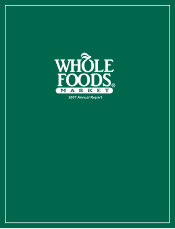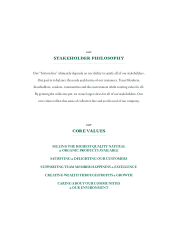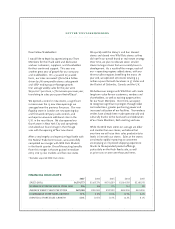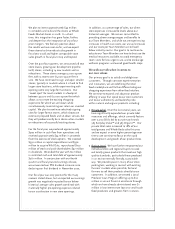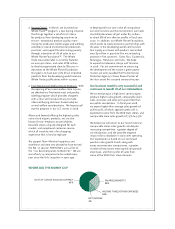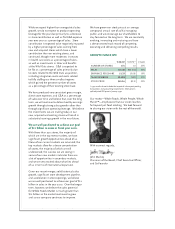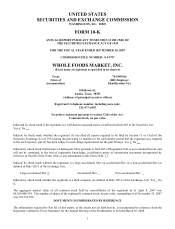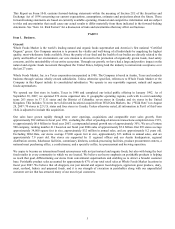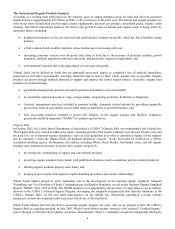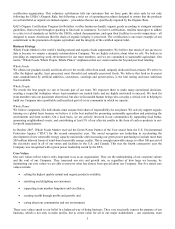Whole Foods 2007 Annual Report Download - page 4
Download and view the complete annual report
Please find page 4 of the 2007 Whole Foods annual report below. You can navigate through the pages in the report by either clicking on the pages listed below, or by using the keyword search tool below to find specific information within the annual report.
We plan to invest approximately $45 million
in remodels and re-brand the stores as Whole
Foods Market stores in 2008. In a short
time, this integration has gone faster, further,
and deeper than the integration of any of our
prior mergers. We feel very positive about
the results we have seen so far, and we expect
these stores to drive robust sales growth in
fiscal year 2008 and higher comparable store
sales growth in fiscal year 2009 and beyond.
Over the past four quarters, we announced 28 new
store leases, growing our development pipeline
to 87 stores, including 14 new markets and 22
relocations. These stores average 51,000 square
feet, with 13 stores over 65,000 square feet in
size. We have continued to sign and open smaller
stores, typically in markets where it is hard to find
larger store locations, while experimenting with
opening some very large format stores. Our
“sweet spot” for most markets is a footprint
between 45,000 and 60,000 square feet which
allows us to create the exciting shopping
experience for which we are known while
simultaneously maximizing our return on invested
capital. We plan to continue selectively signing
sites for larger format stores, which showcase
extensive prepared foods and sit-down venues, but
they will predominantly be in dense urban markets
or relocations of successful existing stores.
For the fiscal year, we produced approximately
$399 million in cash flow from operations and
received approximately $54 million in proceeds
from the exercise of stock options. We invested
$530 million in capital expenditures and $596
million to acquire Wild Oats, repurchased $100
million of stock and paid shareholders $97 million
in dividends. We ended the year with $2 million
in restricted cash and total debt of approximately
$761 million. In conjunction with our fourth
quarter and fiscal year-end earnings release,
we announced our fifth dividend increase since
declaring our first dividend in November 2003.
Our fiscal year was very positive for the many
reasons stated above, but as expected our earnings
growth was negatively impacted by our below-
historical average sales growth combined with
materially higher pre-opening expenses related
to our acceleration in new store openings.
In addition, as a percentage of sales, our direct
store expenses increased to levels above our
historical averages. We remain committed to
providing above-average wages and benefits to
our Team Members, and while we are experiencing
increases in health care costs, our annual increases
and our costs per Team Member are still well
below industry norms. Our goal is to continue to
educate our Team Members on how to best use the
medical resources available, to avoid emergency
room visits for less urgent care, and to encourage
wellness programs and overall good health steps.
We walk our talk when it comes to
our core values.
Our primary goal is to satisfy and delight our
customers. Through constant experimentation
and innovation, we are redefining the retail
food marketplace and further differentiating our
shopping experience from other food retailers.
We continue to expand and adapt our product
offering in ways that speak to our core customers
and to our authenticity and leadership role
within natural and organic products including:
o
Private Label. Over the last several years, we
have significantly expanded our private label
resources and offerings, which currently feature
over 2,000 SKUs led by our primary brands
365 Everyday Value™ and 365 Organic™. Our
private label sales increased to 18% of our
total grocery and Whole Body sales this year,
and we expect an even higher percentage over
time as we continue to focus on the rapid
development and growth of our product lines.
o
Buying Local. We have further empowered our
individual store and regional buyers to seek
out locally grown products that meet our high
quality standards, particularly those produced
in an environmentally friendly, sustainable
way. We provide space in many of our store
parking lots, working in concert with existing
farmers’ markets when possible, for local
farmers to sell their products directly to our
customers. In addition, we created a Local
Producer Loan Program offering up to $10
million in annual financial assistance through
which we have already administered over $1
million in low-interest rate loans to small-scale
food producers and growers from 12 states.

